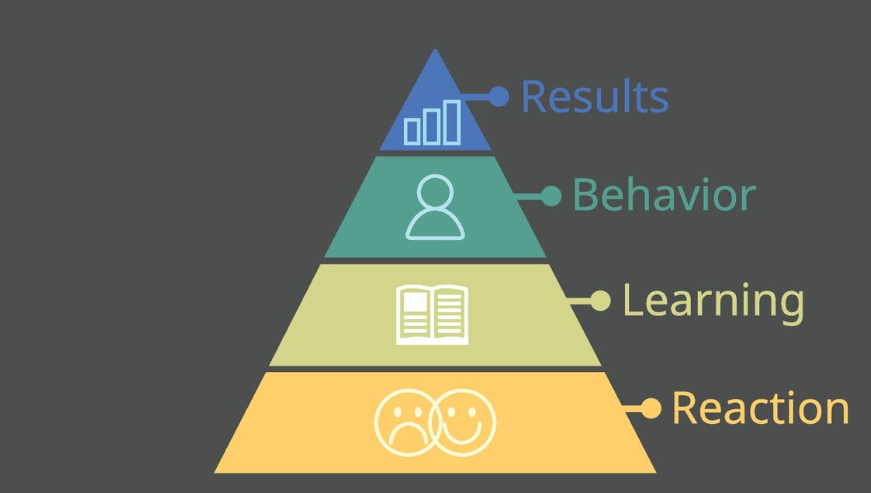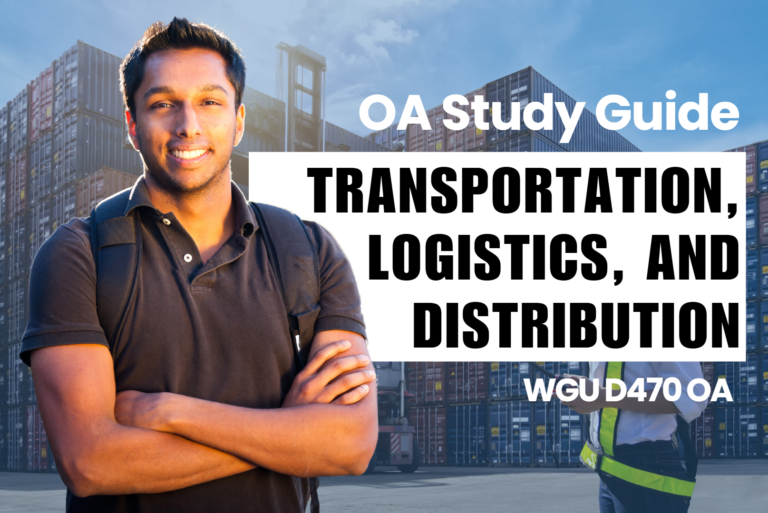WGU C202 OA Study Guide I - 2025 | Mastering Training and Hiring📖
Have you ever sat through a training session that made you wonder, “Is this really helping me, or am I just collecting free coffee and a certificate?” Or maybe you’ve worked at a place where you felt like you just didn’t belong, like a penguin in the desert. Well, you’re not alone!
This article explores two key concepts in human resource management and organizational development that are essential for employee training evaluation and workplace compatibility:
- Kirkpatrick’s Model: A widely used framework for evaluating training effectiveness, Kirkpatrick’s Model consists of four levels: Reaction, Learning, Behavior, and Results. It helps organizations assess how well training programs impact employee performance and business outcomes.
- PO Fit Theory: Person-Organization (PO) Fit Theory examines how well an individual’s values, beliefs, and personality align with an organization’s culture. A strong PO fit leads to higher job satisfaction, better performance, and lower turnover rates.
If you’re tackling WGU C202 OA questions, understanding these concepts will give you a solid foundation in human capital management. So, let’s break things down in a way that actually makes sense—and, dare we say, makes learning fun!
How to Use This Guide for the WGU C202 OA Exam?📖
The C202 Managing Human Capital OA exam at WGU evaluates your understanding of employee training and development, organizational behavior, and human capital management. This guide simplifies the key concepts of Kirkpatrick’s model and PO fit theory to help you grasp the topics tested in the exam.
We also provide exam-style questions and practical applications to ensure you’re fully prepared for the questions on the WGU C202 OA exam.

Understanding Kirkpatrick's Model: A Step-by-Step Guide For C202 OA 📝
Each organization that provides employee training seeks identical performance-based goals that create value for the operation. What standard determines whether training initiatives achieve desired results? Donald Kirkpatrick developed his model in 1959 to deliver an organized framework that enables organizations to assess training programs effectively.
We will examine Kirkpatrick’s Model and its steps through an easy-to-learn explanation in this section. This understanding will prepare you for all related questions in WGU C202 OA.

What is Kirkpatrick’s Model?
Kirkpatrick’s Model is a framework used to assess the effectiveness of training programs. It outlines four levels of evaluation, allowing organizations to measure how well their training meets its objectives. The four levels of Kirkpatrick’s Model are:
- Reaction – What did the learners think of the training?
- Learning – What did the learners actually learn?
- Behavior – Are the learners applying the new skills in the workplace?
- Results – What measurable impact did the training have on the organization?
The individual evaluation levels unite into one complete assessment of training program success because each level measures distinct parts of the training experience.
1. Reaction: How Did the Learners Feel?
The first level of the Kirkpatrick Model focuses on the learners’ immediate reactions to the training. This level helps assess whether the participants found the training valuable and engaging. It answers the question, Did the learners like the training?
How to Measure Reaction
This can be measured through post-training surveys or feedback forms. You could ask questions like:
- Did you find the content of the training useful?
- How would you rate the instructor’s effectiveness?
- Was the training relevant to your job?
In practical terms, let’s say a company organizes a workshop on conflict management. After the session, employees fill out a feedback form. If most of the responses are positive, it’s a sign that the training was engaging and well-received.
The information that emerges from this level allows you to understand participant satisfaction but it provides no clear indication about learning outcomes or real-world applications of the training.
2. Learning: What Did the Learners Actually Learn?
The second level of the model focuses on what the learners have actually learned or retained from the training. Did they gain new skills, knowledge, or attitudes that they didn’t have before?
This level helps measure how well the training material was understood and absorbed. It’s not enough for a participant to like the training (that’s the reaction level); they need to be able to demonstrate that they have learned something useful.
How to Measure Learning
At this stage, you would assess the participants’ knowledge and skills. This could be done using various methods such as quizzes, tests, or practical assessments. You might want to ask questions like:
- Can the participants recall key concepts from the training?
- Do they show improvement in their knowledge of the subject matter?
Participants in a time management workshop perform quizzes about goal-setting principles and time-blocking strategies they learned after the session. Successful completion of the quiz demonstrates the learners have mastered the knowledge.
This level answers the question, Are we teaching the right things? And helps ensure that the content delivered is valuable and relevant to the learners’ roles.
3. Behavior: Are Learners Applying What They Learned?
Evaluation at the third level measures whether learners use acquired knowledge and skills in their work activities. The examination establishes if the training program leads to real-life behavioral modifications.
How to Measure Behavior
To measure this, you need to observe how the learners behave after the training. This could involve:
- Supervisors or managers observing the learners’ actions.
- Interviews with the learners to find out if they’ve implemented the new skills.
- Feedback from colleagues or team members about any noticeable changes in behavior.
Let’s say the training was about handling customer complaints more effectively. In this case, the goal would be to see if the employees are handling customer complaints differently than before. Are they using the techniques taught in the training, like active listening or offering solutions, when they deal with difficult customers?
If the behavior is changing, it suggests the training is working. If not, the training may need to be revised or reinforced.
The observation of substantial behavioral modifications might require months after implementing training at this evaluation level. The process of adopting new habits occurs over time since skills need adequate time for workplace implementation. Through Kirkpatrick’s Model, the actual impact of training emerges gradually over weeks and potentially months.
4. Results: Is the Training Making a Difference?
The final level in Kirkpatrick’s Model is all about measuring the ultimate outcomes of the training. Are the changes in behavior leading to real, tangible results for the organization? This level focuses on whether the training contributed to achieving business goals.
How to Measure Results
At this level, you would assess organizational outcomes that are directly related to the training. Examples of measurable results include:
- Increased productivity
- Improved quality of work
- Higher sales or customer satisfaction
- Reduced employee turnover or absenteeism
A business organization delivers leadership development sessions to its managerial workforce. The organization follows up by monitoring activity data that includes team output and employee acceptance ratings. Natural improvements in performance indicators throughout the company signify that the training program produces beneficial outcomes.
Results can also include less tangible factors like employee morale or engagement. These factors can be harder to measure directly but are still critical for understanding the overall success of the training program.
Why Kirkpatrick’s Model Matters in the Workplace
Kirkpatrick’s Model provides a clear framework for evaluating training effectiveness, and it’s widely used by organizations to ensure their training programs deliver real value. But why does this matter? Here are some key reasons:
- Improved Training Programs: By measuring training at all four levels, companies can identify areas where their training may be lacking and make adjustments to improve future programs.
- Return on Investment (ROI): Companies spend a lot of money on training, and the fourth level of Kirkpatrick’s Model helps measure whether that investment is paying off in terms of improved results.
- Employee Development: Training isn’t just about the company—it’s also about the employees. By evaluating how well employees are learning and applying new skills, organizations can better support their development and growth.
Understanding Person-Organization Fit (PO Fit) Theory: A Key to Successful Hiring For C202 OA📝
Creating a productive and successful workplace in human resources depends most significantly on placing suitable personnel in their optimal positions. The first theory that comes into play here is the Person-Organization Fit (PO Fit) Theory. The fundamental principle of this theory focused on identifying the connection between employee values and beliefs and organizational culture alongside goals and values.
PO Fit Theory plays an essential role because it creates an environment that motivates employees leading to higher performance and increased job satisfaction together with reduced employee turnover. This segment analyzes PO Fit Theory including its operation principles and organizational importance for recruiting and maintaining appropriate staff members.
What is Person-Organization Fit (PO Fit)?
Person-Organization Fit (PO Fit) defines how well an employee matches his or her organizational work environment. Employee characteristics that match up with organizational values determine their cultural compatibility. The employee along with the organization obtain mutual advantages from an ideal match between their values and organizational culture.
Employee success in workplace culture depends on them matching the organizational system like how puzzle pieces slot perfectly into place. When employee-fitting relationships prove correct then employees become more contented and motivated at work which leads to superior organizational performance. Employment dissatisfaction coupled with reduced engagement often exists alongside high turnover rates whenever an employee and organization have a mismatched fit.
Why is PO Fit Important?
Person-Organization Fit is crucial for a variety of reasons, and organizations that pay attention to it are more likely to experience long-term success. Here are some key benefits of ensuring a good PO Fit:
- Higher Job Satisfaction: PO Fit creates successful workplace matches between staff members and organizations because mutual alignment exists between both entities. Organizations need to evaluate their cultural support for employee needs because this aspect influences the employee’s satisfaction level as much as their individual contributions.
- Improved Performance: Employees who feel that their personal values match the company’s culture are more likely to be motivated and productive. They’re more engaged in their work and more committed to achieving organizational goals.
- Lower Turnover Rates: When there’s a strong PO Fit, employees are less likely to leave the organization. High turnover can be costly for companies, both in terms of time and resources. By ensuring a good PO Fit, organizations can reduce turnover and retain talented employees for the long term.
- Cultural Harmony: A good PO Fit helps to create a harmonious workplace culture. Employees who share similar values and attitudes are more likely to get along with each other, collaborate effectively, and contribute to a positive work environment.
How Does PO Fit Work?
PO Fit is about finding a match between the employee and the organization, but it’s important to understand that the “fit” goes both ways. It’s not just about what the employee brings to the table, but also about how well the organization’s culture supports the employee’s needs and preferences.
There are two main types of PO Fit:
- Person-Organization Values Fit: Organizational and employee values need to closely match in order to achieve this fit type. A company that seeks innovative risk-taking employees should hire those who bring creative problem-solving skills to their roles. The employee who affiliates with stable institutions will avoid working within risk-embracing environments because they feel insecure.
- Person-Organization Personality Fit: The assessment checks if a worker fits well by comparing their individual characteristics to the established cultural elements of their organization. An organization driven by team collaboration would perform best when its staff members demonstrate openness and group communication ability while finding pleasure in teamwork. The organizational values of independence and self-direction work best for personnel who enjoy personal work without much collaboration.
Both types of fit are essential for ensuring a positive work environment where employees can thrive. When an employee’s values and personality align with the organization’s culture, they are more likely to stay engaged, motivated, and satisfied in their role.
How Do You Measure PO Fit?
Measuring PO Fit can be a bit tricky, as it involves both subjective and objective factors. However, there are several tools and techniques organizations use to assess how well a candidate fits with their culture and values:
- Interviews: Hiring managers use interview assessments to determine if a candidate matches their organizational values while displaying their personality type. Through behavioral questions, the interviewing manager seeks to understand the candidate’s previous actions because these behaviors demonstrate if they share organizational values.
- Personality Tests: Some organizations use personality assessments to determine whether a candidate’s personality traits align with the company culture. These tests can help measure factors like extroversion, openness to new experiences, and problem-solving skills.
- Cultural Fit Surveys: Organizations measure cultural compatibility through employee rating surveys which examine the value significance of different organizational principles and then compare candidate responses to these results. The assessment technique shows organizations which candidates’ core values align with the organizational values.
- Onboarding and Trial Periods: PO Fit evaluation can be measured through the onboarding process that organizations employ. An employer uses the first few months of employment to determine how well their new employees integrate with the organizational culture and adapt to their duties. An employee’s evaluation backed by feedback from their peers enables organizations to check the alignment and resolve first-time problems in the hiring process.
PO Fit in Action: Examples from the Real World
Let’s look at a couple of examples to better understand how PO Fit works in practice.
Example 1: Google’s Innovation-Driven Culture
The workplace environment at Google stands out because of its creative and innovative character. The company selects workers who display both a thirst for learning as well as inventive qualities and risk-taking abilities. The recruitment system at Google measures specific qualities that the organization seeks to hire in new team members. Professional success becomes challenging for employees who enter Google because they treasure stability when they encounter an industry known for its rapid operations and constant risks. Such environments suit staff members who remain enthusiastic and dedicated at work.
Example 2: Healthcare Organizations with a Service-Oriented Culture
A healthcare organization needs all workers to demonstrate exceptional dedication toward assisting others. Individuals who enter the organization motivated mainly by money or personal objectives often lack dedication to show compassion in their patient care. Staff members who place importance on providing assistance to others join organizations in a seamless way which drives beneficial results for patient healthcare along with workforce contentment.
PO Fit and Organizational Success For C202 OA
A good PO Fit contributes to overall organizational success. The alignment of trustworthy staff members with suitable positions in the organization enables beneficial outcomes toward company targets. The strong alignment of personalities between organizations and workers through PO Fit generates settings where employees and organizations successively achieve optimal performance.
In the context of WGU C202, understanding PO Fit Theory is crucial for anyone involved in human capital management. The theory serves as a blueprint for organizations to build effective harmonious work environments while teams develop recruiting systems for employee assessment and cultural refinement programs. The strategy can be used for practical purposes in addition to theoretical contexts so it helps students solve WGU C202 OA questions.
Tired of reading blog articles?
Let’s Watch Our Free WGU C202 Practice Questions Video Below!

Final Thoughts: Ace Your WGU C202 OA with Confidence 📖
You’ve now mastered Kirkpatrick’s Model and PO Fit Theory, two essential concepts in human capital management. Kirkpatrick’s Model helps organizations measure the effectiveness of training programs, while PO Fit Theory ensures that hiring isn’t just about skills but also about cultural alignment.
These topics aren’t just theory—they’re key to building better workplaces and will definitely appear in your WGU C202 OA. Devote sufficient time to examine the questions before mastering their practical implementations to solve WGU C202 OA questions confidently.
You should strive for comprehension along with passing the exam since this knowledge will benefit your career. Continue your focus on practice while having faith in your ability. You’ve got this! Good luck, and may your study sessions be productive (and your coffee never run out)!






